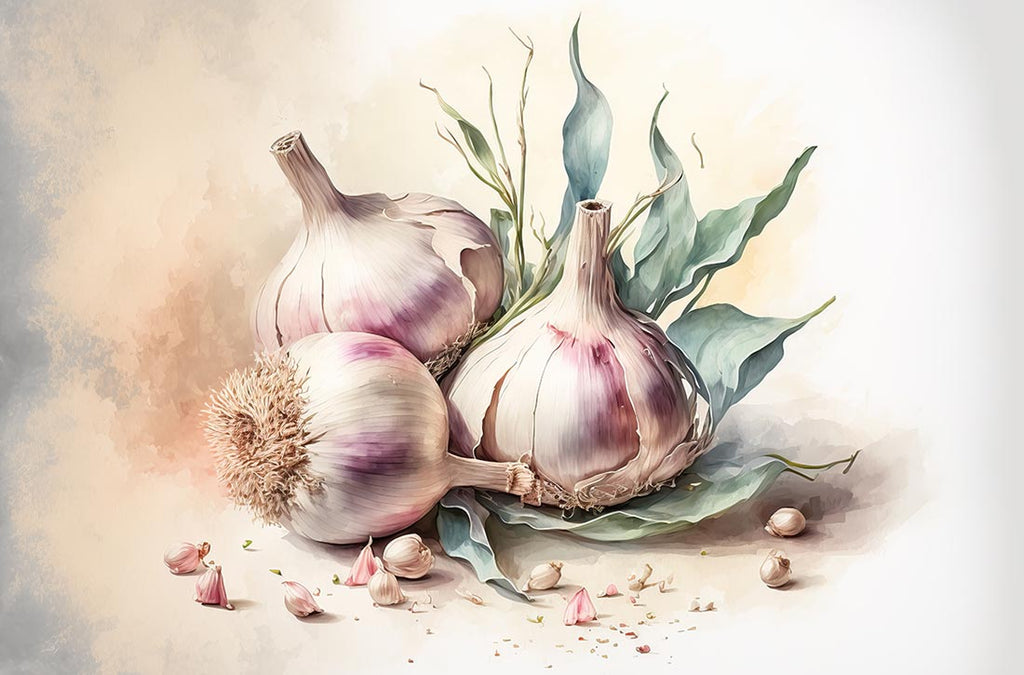Benefits of Garlic

What is Garlic?
Garlic is a perennial plant, native to Asia, grown for its flavorful bulbs commonly used as flavoring in cooking and for its medicinal properties. It is closely related to rakkyo (onion found in Asia), scallion, chive, leek, and shallot. For thousands of years, garlic has been used not only for cooking but also for its medicinal properties. Many of us are not very familiar with just how amazing garlic is. It deserves to be known for much more than just as stinky or, in folklore, a defense against vampires.
The use of garlic has been documented in many major civilizations such as the Greeks, Romans, Egyptians, Babylonians, and Chinese.
As previously mentioned, garlic has been around for thousands of years and has been used all over the world. Richard S. Rivlin wrote in the Journal of Nutrition that Greek physician Hippocrates (known as the father of Western medicine) prescribed garlic for a variety of health conditions and illnesses.
Health Properties of Garlic
Scientists over time have learned that most of garlic’s health benefits are caused by sulfur compounds that are formed when garlic cloves are chewed, crushed, or chopped. Some of the compounds found in garlic include:
- Allicin
- Diallyl disulfide
- Sallyl cysteine
The compounds found in garlic promote strong biological effects on the body and research has found that they promote antithrombotic, antimicrobial, antifungal, antitumoral, hypoglycemic, hypolipemic, hypotensive, and brain-protective properties. That’s a lot of good stuff.

What are the Health Benefits of Garlic?
Promotes protection against illnesses such as the common cold- Garlic is believed to support the immune system and give it a boost when needed. Some studies have found that garlic reduced the number of colds, reduced the average length, and reduced the number of symptoms in their research groups. If you are prone to getting sick often, you may want to consider including garlic in your diet.
Promotes reduced blood pressure- High blood pressure is one of the most important factors that can lead to cardiovascular diseases. Several studies have found that garlic promotes lower levels of blood pressure in hypertensive individuals.
Promotes improved cholesterol levels- Garlic appears to support lowered LDL (bad) cholesterol levels. Garlic supplements appear to lower bad cholesterol by about 15%-20% in some individuals.
Supports healthy blood sugar levels- The compounds found in garlic appear to improve glycemic control by promoting improved insulin sensitivity, glucose tolerance, and insulin secretion.
Supports brain health- Garlic is rich in antioxidants that protect the body against oxidative stress caused by free radicals, which can affect aging. By promoting lower levels of cholesterol, reduced high blood pressure, and its strong antioxidant properties, garlic can help support brain health.
Potential antibiotic properties- The compound diallyl sulfide, found in garlic, is believed to promote strong antibiotic properties against some bacteria.
Promotes lung health- Allicin in garlic contains antioxidant properties that may relieve respiratory issues and promote comfortable breathing.
Promotes anti-inflammatory properties- Garlic contains diallyl disulfide which is an anti-inflammatory compound. It limits the effects of pro-inflammatory cytokines.
Promotes anti-fungal properties- Fungal infections can be quite common and quite annoying when they are recurrent. Garlic contains ajoene, which is a powerful anti-fungal agent. Garlic may assist in slowing down the growth of certain fungal and yeast infections.
This list of benefits will probably make many of us overlook the most known side effect of garlic: bad breath!
Tips on How to Include Garlic in Your Diet
Garlic can be pretty easy to add to your diet as it comes in many forms. Garlic extract is also available in supplement form and there are a variety of odorless options. Here are a few ways you can start adding garlic to your dietary routine:
- Minced and sprinkled over a salad
- Pressed and mixed with olive oil and salt to make a dressing
- In soup
- Include it when making a veggie smoothie
- Make a garlic wellness shot
Garlic Supplements
Is garlic just not your cup of tea? No problem. Here at Health Hispanica®, we offer Garlic 3000™ from Natura-Genics® for individuals who prefer garlic in supplement form. It is a combination of deodorized (yay) garlic extract 50:1 plus four additional herbs to complement and enhance all of garlic’s health properties. It contains:
- Deodorized garlic
- Parsley leaves
- Cayenne fruit
- Nettle leaves
- Dandelion root
Try it today and start enjoying all the health benefits garlic promotes!
Your Hispanic American Health Store
Health Hispanica® is a Hispanic-American health store specializing in supplements from Hispanic-American-owned brands such as Natura-Genics® and Yerba Farma®. We strive to provide quality and innovative supplements at fair prices and educate our clients and community on healthy living.
The statements above have not been evaluated by the Food and Drug Administration (FDA). This product is not intended to diagnose, treat, cure, or prevent any disease.



Leave a comment